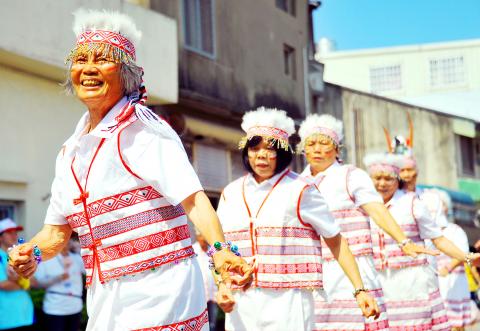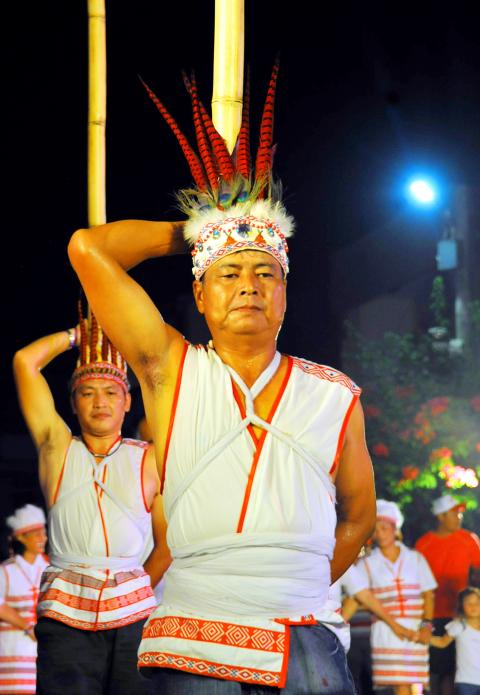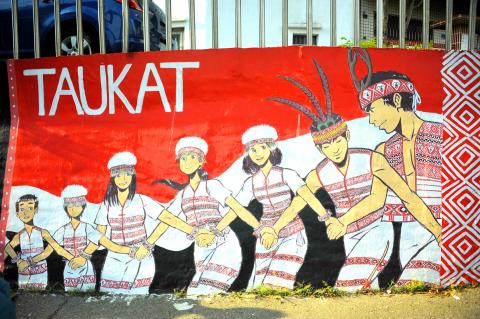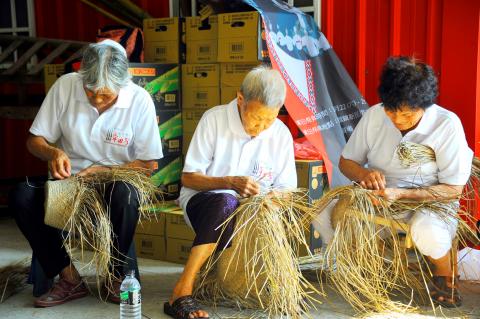Growing up, Lauyi’s father and grandfather were adamant that they were not indigenous, despite looking the part. Even when the family moved back to the ancestral village of Singang (新港) in northern Miaoli County when she was around 10 years old, they only said that indigenous people once lived here.
“When I said that my classmates at school told me that I lived in an indigenous village, the family elders appeared upset and replied, ‘They are talking nonsense,’” Lauyi recalls.
In 2002, the village revived its Kantian harvest festival, which had not been held since the end of World War II. Lauyi participated it in for the first time in 2008 when she returned home from college, and she finally learned the truth.

Photo: Han Cheung, Taipei Times
Lauyi’s family were members of the Taokas, a Pingpu (平埔) or plains indigenous people who once occupied territory along Taiwan’s west coast from northern Hsinchu to northern Taichung. She further confirmed her identity when she found her family’s old household registration documents, which showed that her paternal grandparents and all previous generations were labeled shou (熟, a Qing Dynasty and Japanese-era term for a “tamed” or “civilized” indigenous person). She says it was an emotional moment.
Now running a Taokas fusion restaurant in the village, Lauyi was ecstatic this past weekend because the harvest festival was taking place again after a four-year hiatus.
With her people having to hide and suppress their customs for so long, and with the Taokas (and other Pingpu groups) still not officially recognized by the government, Lauyi sees the revival of her culture as a long process that may take generations. And although not all of her peers feel as strongly as she does toward their identity, Lauyi was glad to see many of them return home for the event.

Photo: Han Cheung, Taipei Times
“At least my nieces and nephews will introduce themselves at school as Taokas,” she says. “Even if you can’t motivate the entire community, I feel that we’re off to a good start.”
CULTURAL REAWAKENING
While most of the Taokas were either assimilated or forced out of the area over the years, the people of Singang endured as they set up fortified defenses and refused to intermarry with the surrounding Han Chinese until relatively modern times. Legend tells of a village elder at the turn of the 20th century who was favored by the Japanese, and even went on a tour to Japan to show off Taokas culture, contributing to the preservation of the community.

Photo: Han Cheung, Taipei Times
But by the time Liu Hsin-miao (劉新苗) was growing up in the 1950s, the village had entirely shifted to using Hoklo (also known as Taiwanese) and Mandarin, with old people only using few Taokas words in their everyday speech.
“For example, the elders would say drink gyakaw,” he says. “I knew that meant alcohol, but I had no idea that that was from our original tongue.”
Most people in the village go by Chinese names — the majority surnamed Liu — and were never given indigenous names.

Photo: Han Cheung, Taipei Times
Cultural assimilation to the surrounding Hoklo and Hakka peoples was also significant, and Liu estimates that they only kept about 20 percent of their original customs such as bamboo weaving as well as certain culinary practices.
As Taiwan’s economy took off in the 1960s, few opportunities trickled down to the community, causing them to become increasingly afraid and ashamed of admitting to being indigenous due to discrimination, Liu says. Lauyi says her father and grandfather’s denial of their heritage only started to change after the revival of the festival.
By the early 2000s, Liu and his people decided that it was time to reclaim their identity. With the culture being lost for so long, they had to visit Academia Sinica and National Taiwan University to relearn the festival songs and procedures from old Japanese-era texts, and recreate their traditional clothes and headdresses. They also started interviewing elderly residents in their 70s and 80s, awakening their dormant cultural and linguistic knowledge.
Today, colorful murals depicting Taokas life and customs dot the otherwise nondescript village that is indistinguishable from on that is Han Chinese — a Taoist temple even anchors the central plaza. Signs showing Taokas vocabulary and their Chinese translations also line the main roads, and at the village entrance there’s a bamboo gate that is designed after the old fortifications that once kept outsiders at bay.
TEACHING A LOST TONGUE
While Liu delved into the historical and cultural aspects, his daughter Kala became the village’s language “expert,” though she would never call herself that as she maintains that she is far from fluent. She developed an interest in linguistics during college and started documenting and learning the language in 1997.
Kala learned enough to start teaching around 2011, but it was difficult as each age group preferred a different way of transliteration — the children using bopomofo, some using Chinese characters and older people using Japanese. Few were comfortable with Romanization.
As the Taokas are not yet a recognized group by the government, they cannot legally teach their language in public schools. Today, Singang Elementary School occasionally has after-school language classes, and Kala and a group of villagers in their 20s and 30s, including Lauyi, get together about once a month to practice.
Kala radiated pride as she listened to her two children deliver speeches in Taokas during Saturday’s opening ceremony for the harvest festival.
“They don’t practice it much so they forget it easily, but they’re willing to learn,” she says. “They feel that if they are to introduce themselves at school as Taokas, they should know more about what makes us unique.”
Lauyi admits to being a poor language learner, but quips that she’s proficient with Taokas swear words.
“I haven’t considered the degree of fluency I want to achieve. But we have to start somewhere. We cannot let the language disappear again.”
TAOKAS REUNION
While Lauyi says that not all villagers are comfortable fully identifying as Taokas, it must have been a stark contrast for Liu, from having to hide his identity in his youth to watching the festival host yell “Isn’t the Taokas tribe great?” (道卡斯族讚不讚?) during a group photo session.
A few Taokas from other parts of Taiwan also visited the festival to help out, each having a similar story as Lauyi — only finding out about their heritage in recent decades.
“I feel that the cohesion in this village is strong,” says Hsinchu native Liao Kuo-hung (廖國宏), who spent most of his life thinking that his family was Hakka. “What strikes me is that it’s not just middle-aged or older people participating in this festival. It’s people of all ages.”
Kaisanan Ahuan hails from a branch of the Taokas people who migrated to Nantou County’s Puli more than a century ago. As their numbers are much fewer than the roughly 1,800 who live in Singang, they no longer have harvest festivals and have a weaker sense of identity.
“It was our parents’ generation that was cut off from our culture,” he says. “My generation has regained a strong sense of Taokas identity, and we actually connect better with the elders. But there are those who still refuse to admit to being indigenous.”
Lauyi puts it simply: her grandparents denied their identity, her parents acknowledged it tacitly and her generation fully embraces it.
When asked if there is still discrimination against indigenous people, Kaisanan and his two companions reply “yes” without hesitation. Stereotypes remain and are perpetuated, especially in the media where his companion angrily states that some indigenous celebrities even make fun of themselves.
As the CEO of the Central Taiwan Pingpu Indigenous Groups Youth Alliance, one of Kaisanan’s main goals is the eventual recognition of the various Pingpu groups by the government. A bill has been passed by the Executive Yuan, but it remains stuck in the legislature, he says. Liu has also worked tirelessly over the past two decades toward this goal.
“For now, we can’t rely on the government,” Kaisanan says. “We have to preserve our culture ourselves. For example, the Indigenous Languages Development Act [passed last June] has nothing to do with us. But we would really like it to.”

On April 26, The Lancet published a letter from two doctors at Taichung-based China Medical University Hospital (CMUH) warning that “Taiwan’s Health Care System is on the Brink of Collapse.” The authors said that “Years of policy inaction and mismanagement of resources have led to the National Health Insurance system operating under unsustainable conditions.” The pushback was immediate. Errors in the paper were quickly identified and publicized, to discredit the authors (the hospital apologized). CNA reported that CMUH said the letter described Taiwan in 2021 as having 62 nurses per 10,000 people, when the correct number was 78 nurses per 10,000

As we live longer, our risk of cognitive impairment is increasing. How can we delay the onset of symptoms? Do we have to give up every indulgence or can small changes make a difference? We asked neurologists for tips on how to keep our brains healthy for life. TAKE CARE OF YOUR HEALTH “All of the sensible things that apply to bodily health apply to brain health,” says Suzanne O’Sullivan, a consultant in neurology at the National Hospital for Neurology and Neurosurgery in London, and the author of The Age of Diagnosis. “When you’re 20, you can get away with absolute

May 5 to May 11 What started out as friction between Taiwanese students at Taichung First High School and a Japanese head cook escalated dramatically over the first two weeks of May 1927. It began on April 30 when the cook’s wife knew that lotus starch used in that night’s dinner had rat feces in it, but failed to inform staff until the meal was already prepared. The students believed that her silence was intentional, and filed a complaint. The school’s Japanese administrators sided with the cook’s family, dismissing the students as troublemakers and clamping down on their freedoms — with

As Donald Trump’s executive order in March led to the shuttering of Voice of America (VOA) — the global broadcaster whose roots date back to the fight against Nazi propaganda — he quickly attracted support from figures not used to aligning themselves with any US administration. Trump had ordered the US Agency for Global Media, the federal agency that funds VOA and other groups promoting independent journalism overseas, to be “eliminated to the maximum extent consistent with applicable law.” The decision suddenly halted programming in 49 languages to more than 425 million people. In Moscow, Margarita Simonyan, the hardline editor-in-chief of the